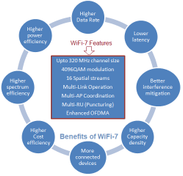WiFi Offloading: Advantages and Disadvantages in Cellular Networks
Advertisement
Wi-Fi offloading is a technique used in cellular networks to reduce traffic on mobile data networks by redirecting data-intensive tasks to Wi-Fi networks. This strategy helps alleviate congestion on cellular networks, improve data speeds, and enhance the overall user experience. Offloading can occur automatically when a device detects a Wi-Fi network that meets certain criteria, or users can manually switch to Wi-Fi to save on cellular data usage.
Wi-Fi offloading is particularly beneficial in densely populated areas like cities, stadiums, and airports, where mobile networks often struggle with heavy loads. By leveraging existing Wi-Fi infrastructure, service providers can manage network traffic more efficiently, delivering better service quality to users.
Key Mechanisms for Wi-Fi Offloading
- Access Network Discovery and Selection Function (ANDSF): Helps devices discover available Wi-Fi networks and select the optimal connection based on operator policies.
- Hotspot 2.0 / Passpoint: Provides seamless and secure automatic connection to certified Wi-Fi networks, making offloading more user-friendly and reliable.
- IP Flow Mobility (IFOM): Allows simultaneous use of cellular and Wi-Fi networks for different types of traffic, optimizing the performance and user experience.
- Multipath TCP (MPTCP): Enables the splitting of data streams across Wi-Fi and cellular networks, improving resilience and speed.

Advantages of WiFi Offloading
Following are the benefits or advantages of WiFi offloading:
- By shifting data traffic from cellular to Wi-Fi networks, offloading reduces congestion on mobile networks, resulting in improved performance, lower latency, and higher data speeds for users.
- Wi-Fi offloading can help users save on their mobile data plans by using free or less expensive Wi-Fi connections for data-intensive activities like video streaming, downloading large files, or app updates.
- Offloading to Wi-Fi can lead to better connectivity, especially indoors or in areas with weak cellular coverage, thus enhancing the overall user experience.
- By freeing up cellular network resources, operators can better manage their spectrum and deliver improved service quality, especially during peak usage times.
- Technologies like Hotspot 2.0 ensure a seamless transition between cellular and Wi-Fi networks, maintaining a continuous user experience without manual intervention.
Disadvantages of WiFi Offloading
Following are the drawbacks or disadvantages of WiFi offloading:
- Wi-Fi networks, especially public ones, are more vulnerable to security threats like hacking, man-in-the-middle attacks, and data interception, potentially exposing users to privacy and security risks.
- The quality and performance of Wi-Fi connections can be inconsistent due to factors like signal strength, interference, and network congestion, leading to a less reliable user experience compared to cellular networks.
- Wi-Fi networks have limited range compared to cellular networks, which can result in connectivity gaps when users move out of Wi-Fi coverage areas, leading to interruptions or slower data rates.
- Ensuring seamless and efficient offloading requires compatibility between cellular and Wi-Fi networks, as well as integration of advanced features like ANDSF or Hotspot 2.0, which may not always be supported by all devices or networks.
- Cellular operators often rely on third-party Wi-Fi networks, which they do not control, leading to variability in the availability, performance, and security of offloaded connections.
Conclusion
Wi-Fi offloading is a valuable strategy for managing cellular network traffic and improving user experiences, especially in high-density areas. However, it comes with challenges related to security, coverage and quality of service, which need to be carefully managed to fully realize its benefits.
Advertisement
 RF
RF



